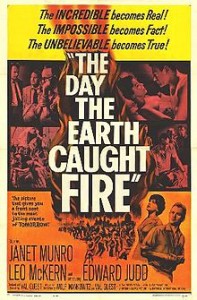The Day the Earth Caught Fire **** (1961, Edward Judd, Janet Munro, Leo McKern) – Classic Movie Review 3642
‘THE PICTURE THAT GIVES YOU A FRONT SEAT TO THE MOST JOLTING EVENTS OF TOMORROW…TODAY! ‘ Co-writer/director Val Guest’s ambitious 1961 apocalyptic British science fiction disaster drama is commendably exciting and briskly paced as well as intelligent and thoughtful. Guest writes with Wolf Mankowitz, and they won the 1962 BAFTA Film Award for Best British Screenplay. It is now judged to be one of the key classic apocalyptic films of its era.
The plot centres on a team of journalists trying to uncover the cause of a series of world disasters and the film works hard at making its British newspaper background as realistic as possible. It features the real-life Daily Express, using the newspaper’s headquarters, the Daily Express Building in Fleet Street, London. And the former real-life Daily Express editor Arthur Christiansen even does an acting turn – quite creditably too – playing himself as the editor of the newspaper, as Jeff Jefferson.
What’s happened is that the US and Russia have both unwittingly tested atomic bombs at the same time, alters the rotation axis of the Earth. Don’t you just hate when that happens! London is devastated by overheating.
The main stars Edward Judd and Janet Munro are perhaps a tad dull as the reporters chasing the news. But the film is an absorbing minor classic. And its central worries – nuclear testing, global climactic changes – seem bang up-to-date.
Also in the cast are Leo McKern, Michael Goodliffe, Bernard Braden, Reginald Beckwith, Austin Trevor, Renée Asherson, Edward Underdown, Peter Butterworth, John Barron, Geoffrey Chater, Robin Hawdon, Gene Anderson and Ian Ellis. A pre-stardom Michael Caine plays an uncredited cop diverting traffic three years before Zulu.
The scenes of the Met Office were filmed outside and inside the Ministry of Defence main building in London’s Whitehall in what was remarkable access offered to the film-makers. The interiors remained little changed till the refurbishment of MOD after 2000.
The film, partly made on location in London and Brighton, uses matte paintings to create images of abandoned cities and desolate landscapes. Other photography includes Battersea Park, the HM Treasury Building in Westminster and on Palace Pier, Brighton.

In the film’s orange-infused opening sequence, Edward Judd walks through a devastated and deserted London.
The film is shot with 35 mm anamorphic lenses using the French Dyaliscope process in black and white. But, in some original prints, the opening and closing sequences are tinted orange-yellow to suggest the heat of the sun.
British Lion weren’t keen on financing an all-British slice of nuclear holocaust fiction and Guest could only finance it by putting up his profits from his 1959 hit Expresso Bongo as collateral.
© Derek Winnert 2016 Classic Movie Review 3642
Check out more reviews on derekwinnert.com





